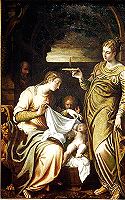 click to enlarge |
THE HOLY FAMILY WITH SAINT LUCYBernardino Campi SN 52, oil on canvas, c. 1555-60 From "The Pages"
|
ARTIST:
Campi was born in Cremona, ‘tho not related to another Campi family of artists there.
He first trained in Cremona with his father Giulio Campi, & for a time in Mantua he
trained with Ippolito Costa. His work, always characterized by attention to detail, was
influenced by Giulio Romano, Pordenone, and especially by Camillo Boccaccino, with whom he
collaborated from 1544.
Bernardino’s fame grew during the 1550s after he moved to Milan, where he executed
numerous works for the nobility. In addition to altarpieces, he painted frescoes. In 1582
he was in the service of Duke Vespasiano Gonzaga in Sabbioneta. His last documented
paintings are the frescoes (1589) in the choir of S. Prospero in Reggia Emilia.
SUBJECT:
St Lucy was a virgin martyr of the early 4th c. in Syracuse, Sicily. An apocryphal story
tells how she plucked out her own eyes after an overzealous suitor admired them; she
wanted no distractions from the devout life. God, however, later restored her sight. She
is thus considered to have the ability to protect those who venerate her against blindness
& other ophthalmic disorders.
PAINTING:
Once again an artist has presented us with a cast of characters who didn’t occupy the
same period of time. They all inhabit a garden setting with an elaborate arbor and
stone-carved bench. Joseph has been relegated to the background, simply peering in, rather
than forming an active part of the group.
The peacock is a symbol of immortality, its 100 “eyes” in the tail representing
the all-seeing church. The tail feathers, which renew themselves, are an allusion to
resurrection.
St John, who stands behind Jesus, is once again shown much older than the Christ Child,
when there was actually only 6 months difference in their ages.